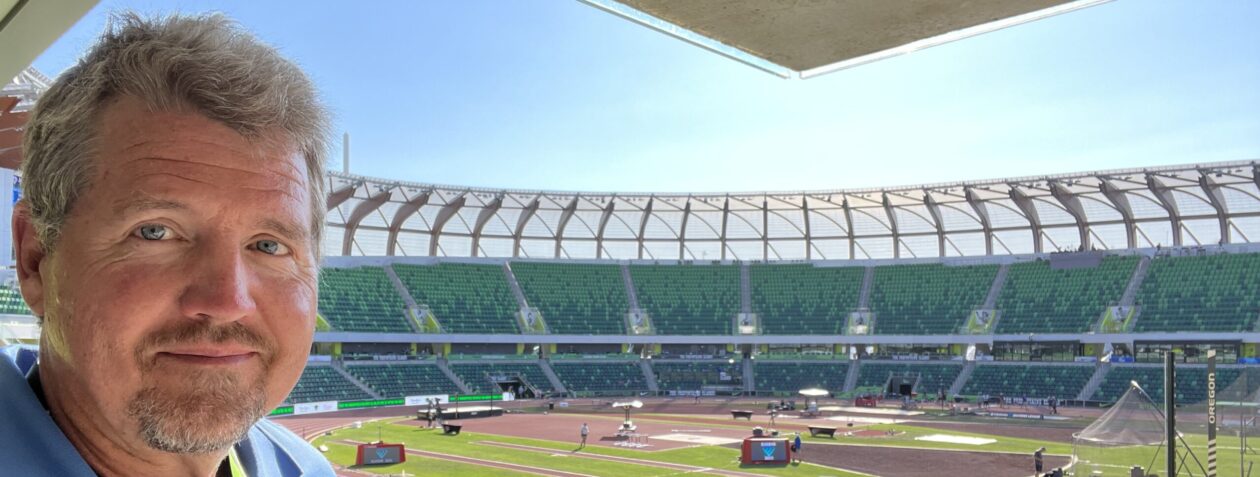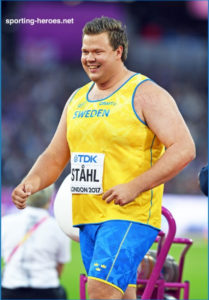Tuesday morning at the European Athletics Championships featured an embarrassment of riches for throws fans. Two rings full of women shot putters vying for the automatic qualification mark of 17.20m that would advance them to Wednesday’s final. And, running concurrently with the women’s shot, two rounds of men’s discus featuring some of the best throwers in the world, among them 2016 Olympic Champion Chris Harting and 2017 World Champion Andrius Gudzius. The qualification line for the men’s disc was 64.00m, which many of these athletes had thrown in previous competitions. But, as it soon became apparent, 64.00m can seem awfully far if something knocks you off your rhythm. The early hour. The unusually hot conditions (Germany, like much of the rest of Europe, is in the middle of an historic heat wave). An unusually fast or slow throwing surface.
Some made qualification look easy.
Christina Schwanitz, much to the delight of the crowd (as she is German and the favorite to snag the gold here) went 18.83m on her first attempt. Thank you, and good day.
Daniel Stahl, the silver medalist at last year’s World Championships in London, also launched his first throw well past the qualification line (it turned out to be 67.07m) raised his arms in triumph and headed off to rest for Wednesday’s final.
On his way out, I asked Daniel if he generally takes something off a first round throw in order to avoid fouling.
“No,” he replied. “Always 100 percent.”
This approach seems to suit the big man’s personality. Stahl is the kind of guy who, if you were a kid, would be your favorite uncle. Large. Easy going. Always smiling. Not the kind of person whose confidence would be ruined by a first round foul.
For some, though, it was not so simple.
Poland’s 2015 World Champion Piotr Malachowski would appear to be cut from the same mold as Stahl. He comes across as very even-keeled, and has been through many, many qualification rounds at major competitions.
Somehow, though, after warming up at 65.00m, Piotr simply could not find his timing when the throws counted. He walked out on his first attempt (it looked to be about 57.00m), caged his second, and misfired badly on his third, ending up without a mark and without an invitation to the finals.
Afterwards, he seemed perplexed.
“My shape today was very good,” he said. “My practice throws were good, then…I don’t know. I don’t know what happened.”
Piotr seemed ready to shake off this experience though. When I asked if he planned to continue throwing through the Tokyo Games, he replied, “Of course. It is my dream. A gold medal!”
While Piotr was suffering his inexplicable meltdown on one end of the stadium, two young shot putters came away from their first ever qualifcation rounds at a senior international competition smiling and utterly delighted to have made the final.
One, British Champion Amelia Strickler, threw a PB of 17.31 on her second attempt.
”I ‘m so excited!” she said afterward. “It was amazing being out there because this is such a big venue, and that’s what you want. You want the big stage. Even though the stadium wasn’t quite full, you could still feel the atmosphere. I can’t wait for the final!”
Like Amelia, twenty-year-old Alina Kenzel surpassed the qualifying line on her second attempt.
Her throw of 17.46m was the seventh best among qualifiers.
She told me afterwards that she was “very excited because it was my first big international event. I was very nervous at the first attempt, but the second it was like ‘okay just do your thing just like training’ and it was the standard for the finals!”
“After my first throw, everybody was saying ‘Alina go on!’ I was like okay,okay, keep going, keep going. Then, it was like boom! I ‘m done, so now I can go to the hotel and have some rest and tomorrow the final.”
Another competitor who seemed just as excited by his success in qualification was the great veteran Gerd Kanter. He threw 64.18m on his first attempt and was positively giddy after.
”I’m old,” he joked. “So, in this heat I have to do it on the first throw. Out there, we were like chickens in ovens.”
After all the success he’s had, including winning the gold at the Beijing Olympics, Gerd still prepares conscientiously for qualification days.
“I would say the qualification procedure is most difficult at these competitions. If you are in the final, it is already like regular competition, but in qualification, you only get two warm-up throws, it is the early morning, it’s not comfortable. So, in training, we practice making a safety throw.”
“We call it a safety throw because you don’t need to go full out. You don’t need 67.00m or 68.00m. The line is 64.00m, so that’s what you need. So, in a safety throw you take less risks. You are not going to go as far back in your backswing, you just make it very simple to avoid errors. One part of training for a championships is we always make two or three throws where the coach says ‘Okay, you need to do a safety throw.’ So not a maximum effort, but you must throw maybe 63.00m.”
The most surprising moment of this qualification day came when defending Olympic champion Chris Harting failed to advance.
Chris showed that he was in good shape two weeks ago by winning the German Championships with a toss of 66.98m, and most observers would have considered him a candidate to challenge Stahl and Gudzius for the title here, in the city where he lives and trains.
But, one chink in Chris’s armor is that his natural release point often sends the discus down the right side of the sector, and depending on the type of the cage, he sometimes has trouble getting off an unimpeded throw.
His coach, Torsten Lönnfors, told me later that the type of cage used for this year’s European Championships makes it difficult for Chris to throw in his natural slot because it is shorter than cages normally used in international competitions, with the front support standard jutting out in just the spot where Chris’s throws often travel. Notice the difference between the cage in the photo above at a different competition, and the one below in a photo from yesterday’s qualification round.
I highlighted the front standard to make it easier to see. Torsten told me that they had tried (and apparently succeeded) in practice to get Chris comfortable throwing with this type of cage, and in warmups he was able to throw a nice, clean 65.00m toss. But, Olympic champions are humans, too, and maybe once that first competition throw ricocheted off the cage…maybe all of a sudden throwing in your home town with all eyes on you and the music turned loud each time you entered the ring…maybe it just got to be too much.
After three throws off the cage resulted in three fouls and a humiliating exit from the competition, Chris had to face a very disappointed German media.
Afterwards, he graciously spoke with me for a few moments. Heartbroken, he struggled for words to describe how this had come to pass.
”It took less than 63 meters to qualify,” he said, shaking his head in amazement. “I can throw that from a stand.”
Just one of those days?
“Yes,” he replied. “That’s a good way to put it. Just one of those days.”










Makes me want to start training! Mutti